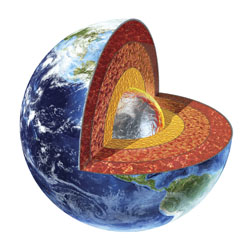Investigating the water content of the Earth's lithosphere
The research formed part of the EU-funded 'Water in the Earth's lithosphere and its bearing on geophysical properties' (NAMS) project. NAMS stands for nominally anhydrous minerals, making up peridotitic rocks that were investigated for water content in this project. More precisely, project researchers studied water content of NAMs in peridotitic xenoliths to construct a model for the distribution of water in the lithosphere, and incorporated this information into geophysical models. They also aimed to improve our understanding of the effect of water on the properties of the lithosphere. Project efforts resulted in the collection of much information about water content in NAMs found in peridotitic xenoliths. This allowed researchers to conclude that the lithosphere is separated into a drier, depleted top layer, and a younger, water-rich lower layer. The novel methods developed during the project have also been applied to various other investigations. Ultimately, the contributions of the NAMS project will improve geophysical models and aid our understanding of plate tectonic movements and the lithosphere in general.







